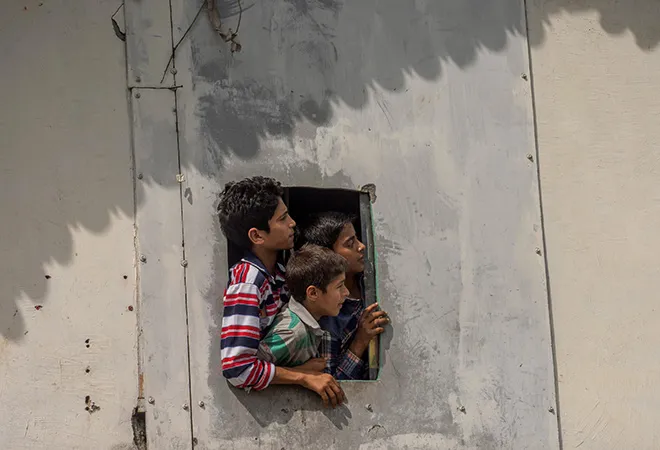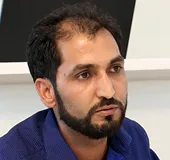-
CENTRES
Progammes & Centres
Location
As Kashmiris stare at an uncertain future, mohalla schools have kept the lamp of education burning for the Valley’s children.

As the sun was rising over the icy peaks in the distance, around 6:15 a.m. on 22 August 2019, I was on my way to the Sher-i-Kashmir Institute of Medical Sciences (SKIMS) in Soura, Srinagar, to see my five-day old baby boy. My son was admitted there for the treatment of some respiratory disorder at birth. Along the 55 km journey from my home in Pulwama, I noticed two children aged six and nine on the eerily deserted Eid Gah-SKIMS road with some books. Seeing two kids on a deserted road walking to their mohalla school is not a strange sight in the conflict-ridden Valley. However, in the uneasy silence that has enveloped the Kashmir Valley since the past month-and-a-half that has brought life to the virtual standstill, noticing two kids on a deserted road was indeed a sight that filled me with hope and despair in equal measure.
Since the unilateral abrogation of Article 370 and the division of the state into two union territories on 5 August, the entire Kashmir Valley has been reeling under curfew. Curfew that was not only enforced by the state, but also the self-imposed civil curfew enforced by the ordinary citizens across all rural as well as urban areas as a mark of protest against the state. Nearly all the roads, including the by-lanes, have been barricaded, along with bunkers manned by heavily-armed security personnel erected at almost every turn and junction. Not a single shop has opened for normal business, no government or private office and no school or college has functioned. Internet has been blocked, mobile telephone networks have been shut. For days, even land lines were silenced. In a nutshell, the population has been robbed of all civil liberties and Kashmiris, since the past 45 days, have been muzzled, shut down and cut-off.
With the rampant proliferation of rumours, misinformation, and hearsay fanned largely on account of the total ban on virtually all channels of communication, parents prefer to keep their wards within the vicinity of their homes. The educational system in the Valley is caught between a rock and a hard place.
Frequent closure of schools and colleges has hampered the educational system in Kashmir. While the academic curriculum has generally remained incomplete because of on-and-off curfews, the quality of education as well as learning standards have also been compromised. It has also meant less accountability of the teachers to maintain teaching standards. Worse, the frequent and long periods of closure of schools has adversely impacted the socio-psychological behaviour of the children and the youth. From July 2016 to 30 May 2017, students lost 60% of school days because of shutdowns, curfews and violence.
During the current crises, despite the government taking the initiative to reopen 190 schools on 19 August 2019, they have not functioned on even a single day since 5 August. With the rampant proliferation of rumours, misinformation, and hearsay fanned largely on account of the total ban on virtually all channels of communication, parents prefer to keep their wards within the vicinity of their homes. The educational system in the Valley is caught between a rock and a hard place. While government has tried to open schools to create a façade of normalcy, people are uncertain and suspicious of the safety of their children if they go to school. Societal pressure to enforce civilian curfew and sporadic instances of stone pelting have added to the cynicism of the parents. Under these circumstances, parents prefer to send their children to mohalla schools or to homes of teachers in their neighbourhoods to ensure continuance of their children’s education.
The unending unrest, near-daily incidents of stone-pelting, armed retaliation by the security forces, frequent and violent encounters and the resulting bloodshed has impacted the overall development of the society. Despite the perennial conflict zone that the Valley has become, education imparted in these mohalla-level informal schools has come to provide the much-needed relief and a sense of freedom and empowerment to the children and their parents. They give a glimmer of hope in the tragic conflict and present crises. After the unrest of 2010, the mohalla schools and schooling with the vicinity of homes, has kept pace with the social transformation within the Valley. Common Kashmiris have discovered these unique ways to impart modern education to the children, bringing a positive change in the societal thinking. As a result, these mohalla schools have developed their own capacities to impart formal school education — though in an informal way — during the times of political crisis and unrest.
Despite the perennial conflict zone that the Valley has become, education imparted in these mohalla-level informal schools has come to provide the much-needed relief and a sense of freedom and empowerment to the children and their parents.
Across the Valley, these mohalla schools have opened up wherever they could find the space and opportunity such as within homes and community centres and even in rented rooms that have been converted into classrooms. The faculty of these neighbourhood schools comprise of volunteers who come from various backgrounds: graduates, post graduates, idle teachers and faculty of closed institutions, researchers and people employed with both public and private sector. This parallel system has evolved to a level where such informal teachers have managed to take care of the academic education during the long spells of violence and curfew that force the schools to shut down. The mohalla schools have, in a sense, also played a significant role in bringing the community together and bridging the socio-economic divide within Kashmiris. During the ongoing political crises, most of these mohalla schools are attended by about 30 students up to class 8. They generally function from 8 to 11:30 a.m. Informal classes for higher secondary students are generally held from 3:30 to 6:30 p.m. in the same premises. A volunteer who teaches mathematics at such a school in Pulwama said, “Political crises and conflict will come and go, but we can’t take the future of kids and students for granted. Already under the several socio-psychological impact of the conflict, education is the only way that the children can be exposed to constructive and positive thinking.”
Most students in their teens preparing for National Eligibility cum Entrance Test (NEET), civil services and other professional exams directly go to the homes of the subject experts for their studies. In Pulwama district, students aspiring for NEET and other exams study in groups and usually take lessons from seniors who have successfully passed these exams.
Thanks to these informal systems, Kashmiri society has responded well after 2010 to ensure that education of the children does not suffer much even during the uncertain times of conflict and unrest. While restoration of normalcy seems to be a distant dream in today’s Kashmir, one of the easiest ways to de-escalate the current crises is by lifting the blanket ban on communications in the Valley. Currently, besides the overbearing presence of heavily armed security personnel everywhere, most parents are wary of sending their children to formal schools because of the fear spread by an unending stream of rumours and misinformation based on hearsay. Till such time communication links are restored, the government may reopen the schools, but it will fail reassure and encourage the parents to send their children to attend them.
The views expressed above belong to the author(s). ORF research and analyses now available on Telegram! Click here to access our curated content — blogs, longforms and interviews.

Ayjaz Wani (Phd) is a Fellow in the Strategic Studies Programme at ORF. Based out of Mumbai, he tracks China’s relations with Central Asia, Pakistan and ...
Read More +